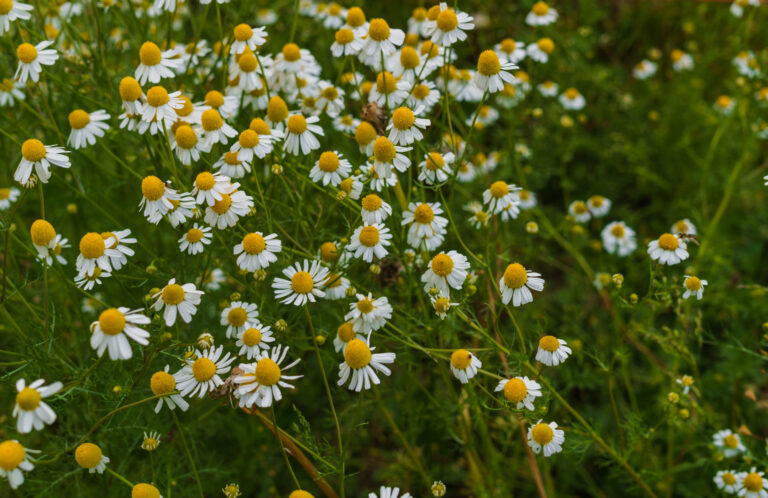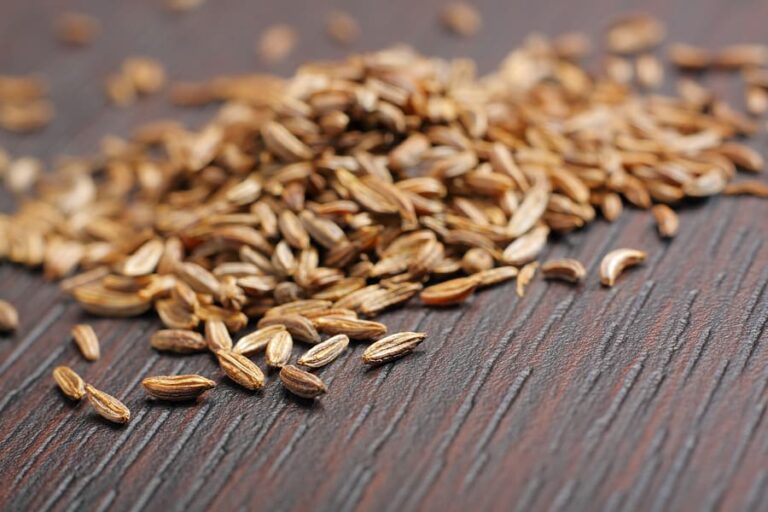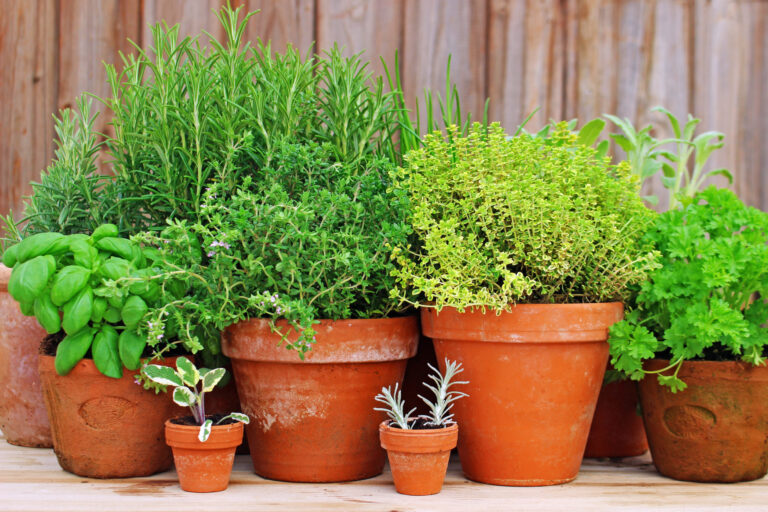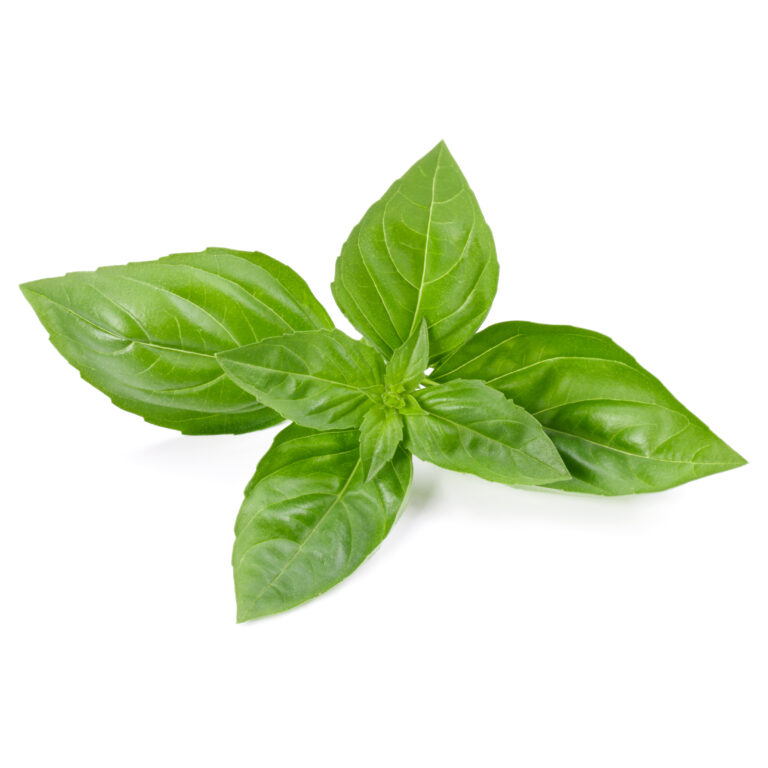How to Grow Herbs
Herbs are not difficult to grow. Most herbs belong to the parsley, the mint, or the daisy families. Most plants in these families germinate readily and can be raised without any special horticultural skill.
Most herbs thrive in well-drained, sunny, loose soil that is not too rich. The planting bed for herbs should be prepared much like the soil for vegetables. It should be turned 18 to 24 inches and forked over several times so that is well-aerated and loose, then smoothed down.
Herb seeds should be sown thinly. After sowing cover the seeds by lightly dusting soil over them and press down with the palm of your hand or a board. In the home garden, herbs are usually not planted in rows.
Most herb seedlings do not require much water; most are native to hot, dry regions. Weeds should be quickly removed near herbs so there is no competition for water or nutrients. A fine dust of mulch around herbs will preserve the moisture in the soil.
If herbs become too thick, they should be thinned. After cutting herbs back, add a little fertilizer above the roots so that they will continue to produce more leafy growth.
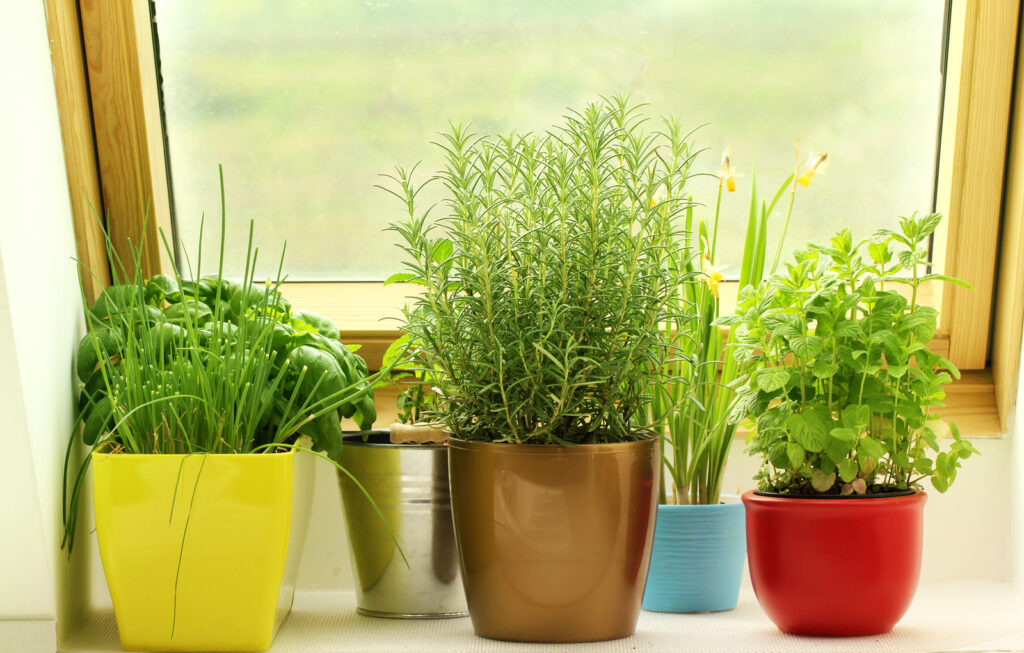
Annual members of the parsley family such as cilantro, cumin, anise, dill, and fennel all grow quickly and take two to three months from seed time to maturity. Annual herbs can be started out of doors, but many gardeners start them indoors to get a jump on the season.
Annual herbs live for one season. Biennial herbs such as parsley flower in the second year, but are most often grown for their leaves which can be harvested the first year. Perennial herbs live for several years and are quite hardy except for tarragon and rosemary.
Annual herbs include basil, summer savory, borage, and sweet marjoram. Biennials include caraway, clary, angelica, and parsley. Perennials include rosemary, tarragon, and thyme.
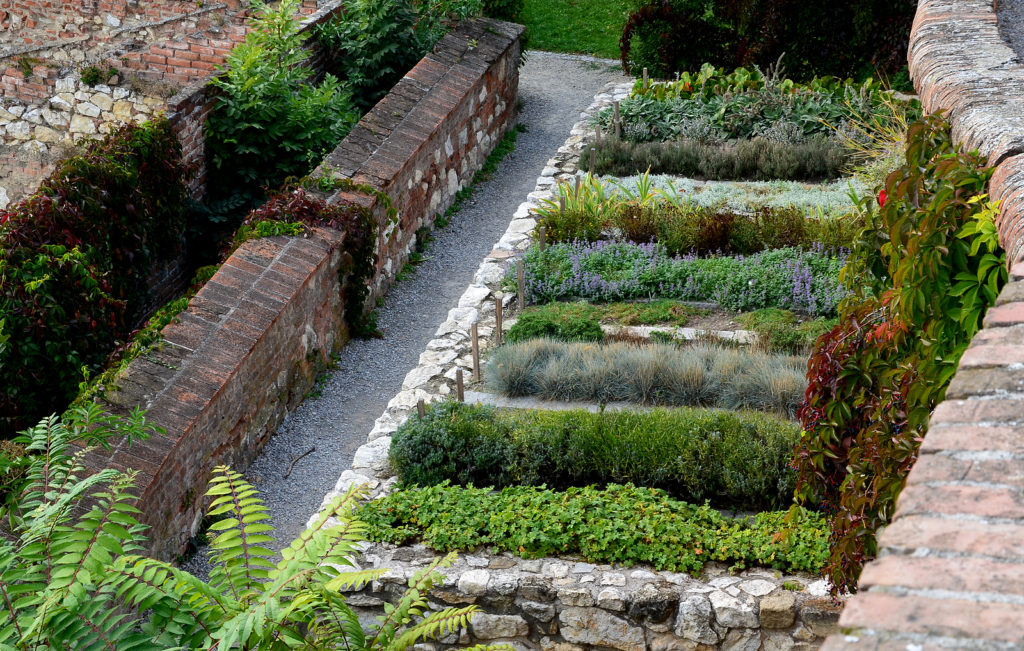
Growing herbs outdoors
Most herbs will thrive in a sunny location, in good garden loam with a neutral pH, and good drainage. A few herbs such as angelica and woodruff prefer partial shade.
Where to plant herbs
Most herbs need at least 6 hours of sunlight each day. Where summer is very hot, herbs will benefit from high shade or filtered light during the middle of the day.
Soil
Plant herbs in well-drained soil. Loam soil is ideal; clay soil will be too moisture retentive; sandy soil will be too porous and not hold moisture.
Loam soil is about 25 to 50 percent organic matter. To amend clay or sandy soil, add leaf mold or aged compost. Herbs grow best with a neutral soil pH.
Prepare the planting area for herbs by turing the soil to a depth of 12 inches or more; break up large clods, Add organic matter across the planting area. Rake the soil smooth, breaking up any large lumps.
When to plant herbs
Start herb seeds with the plant’s hardiness and speed of growth in mind.
Herbs can be started indoors 6 to 8 weeks before the average last frost date for transplanting seedlings into the garden a week or two after the last frost. Don’t start herbs indoors too early or you will end up with spindly, weak plants.
Sow herb seeds in the garden in spring after all danger of frost is past.
If possible, transplant herbs outdoors on an overcast, windless day to avoid transpiration stress from the wind or sun.
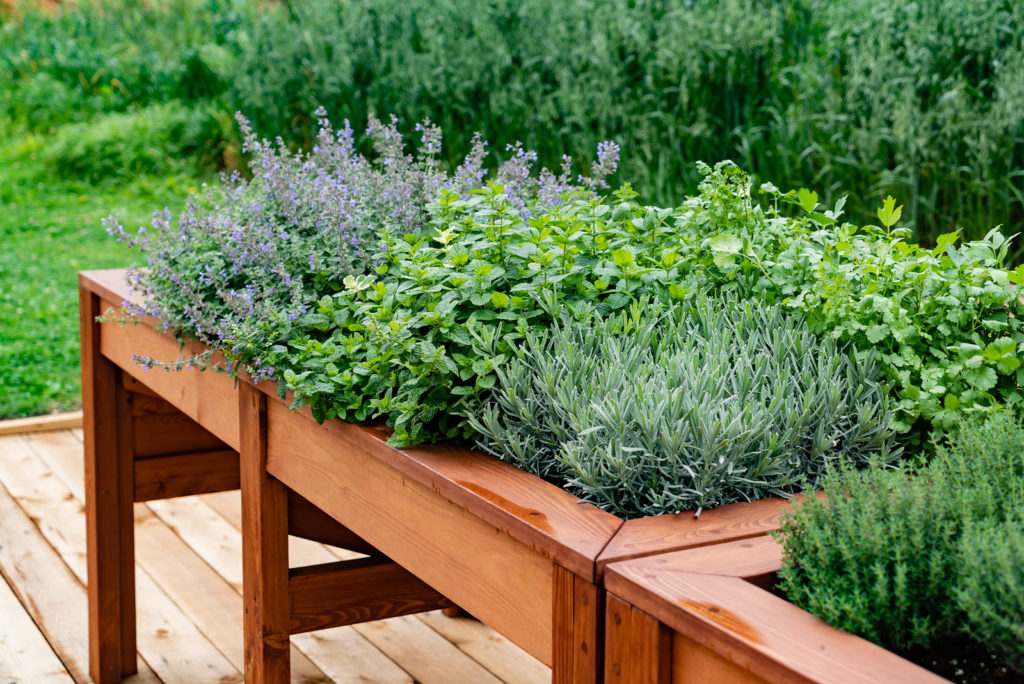
Planting herbs
Sow herb seeds at a depth of twice their diameter. Broadcast very small seeds on the soil surface and light cover with finely sifted soil. Firm the soil and moisten it with a fine spray of water. Keep the soil moist but not soggy until the seeds germinate.
When two true leaves develop, thin seedlings to the proper spacing by removing the smaller, weaker ones.
When transplanting herbs, leave a clump of soil around the roots. Water after the plants are set in place to ensure good contact between roots and soil.
Protect small plants from birds and wildlife by covering young plants with permeable floating row covers.
Spread a layer of organic mulch around plants to protect the soil surface, retard evaporation, and moderate the soil temperature if sunlight is intense.
Watering and feeding herbs
Annual and biennial herbs need regular watering. Perennial herbs need regular water until established during the first year.
Herbs commonly need a thorough watering once a week. If the weather is hot or windy or if the soil is sandy, plants will likely need watering more often. Overwatering will cause herbs to lose their flavor or fragrance and may even kill the plants.
Group herbs together that have similar moisture needs.
Deep watering encourages the roots to grow down. Light watering encourages shallow roots. Shallow-rooted plants may not survive hot weather. Mix organic matter into the soil when preparing beds and mulch around plants with organic matter to retain soil moisture.
Once established, most herbs do best in dry soil and need watering only during very hot weather or drought. A few such as mint and lovage prefer moist soil.
Most herbs do not require regular feeding. One annual feeding of a 5-10-10 organic fertilizer is usually sufficient. Water immediately after you fertilize.
Pest control
Herbs are seldom troubled by diseases or insect pests. Many herbs make excellent companion plants to repel pest insects in vegetable and flower gardens. Chives, peppermint, and tansy repel aphids; basil repels the asparagus beetle; catnip and tansy repel Japanese beetles; cilantro repel spider mites; thyme and wormwood repel whiteflies.
Herbs raised indoors are more susceptible to the common pests of houseplants. Handpick pests off of herbs or remove pests with a spray of water. Persistent infestations can be treated with an insecticidal soap or a pyrethrum-based insecticide.
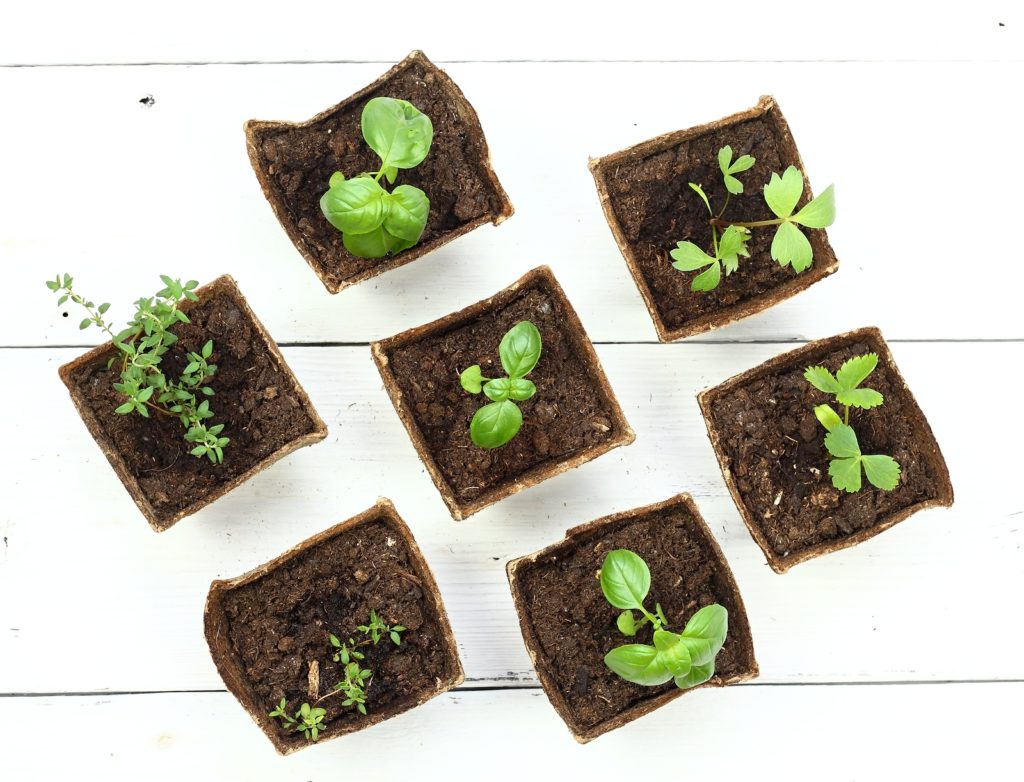
Starting herbs indoors
Herbs can be started indoors about 8 weeks before the average date of the last frost.
Start seeds in flats, cell packs, or individual containers. Use a commercial seed starting medium or a homemaker combination of sphagnum peat moss and fine-grade vermiculite in equal proportions.
Fill the container with the medium and moisten it with a fine spray of water.
Sow the seeds evenly at the same depth as outdoors. Label the containers with the names of the herbs and the date of sowing.
Place the containers in a pan of water and remove them when moisture is visible on the soil surface. Place the containers in a plastic bag to create a mini-greenhouse. Place the bagged herbs in a warm, well-lighted place or under fluorescent lights.
When the seeds germinate, remove the plastic bag and set the plants under fluorescent lights six to eight inches above the seedlings. Rotate the container if the plants start to bend to the light.
Make sure there is good air circulation around the plants and avoid excessive soil moisture; damp soil and poor air circulation can cause a fungal disease called damping off that can kill the seedlings.
When two leaves appear, the seedlings can be transplanted into small individual pots. Use potting soil for the transplanted seedlings. Move the seedling carefully with a ball of soil around the roots.
When plants are large enough to be transplanted outdoors place the outdoors in a shaded place for several hours each day to harden them off. After a few days of gradual exposure to the sun and outdoor temperatures, they can be transplanted into the garden.
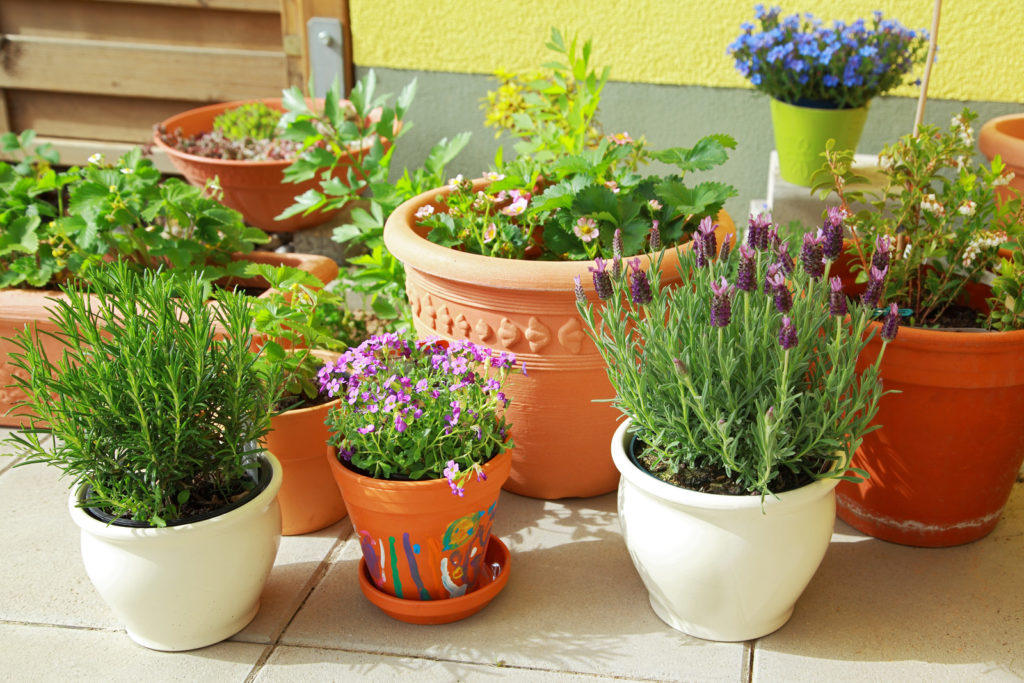
Growing herbs in containers
Almost all herbs will grow well in containers. Select herbs that are in proportion to the container. Herbs often grown in containers include basil, calendula, chamomile, chives, lavender, lavender cotton, parsley, sage, scented geraniums, and thyme.
Kinds of containers
Herbs can be grown in any clean, deep container with drainage holes.
Herbs can be grown in a variety of containers. Be sure the container you choose has holes or slits in the bottom so water can flow through after moistening the soil.
Unglazed terra-cotta clay pots and clay strawberry jars are often used to grow herbs. Monitor water when growing in unglazed clay; the porous surface may result in speedy evaporation of moisture in hot weather.
Noporous glazed clay pots and plastic will retain moisture; be sure these containers have holes in the bottom for drainage.
Wooden containers are somewhat porous, but less so than unglazed clay.
Soil for containers
Soil for containers must be loose enough to allow for easy root growth and water penetration, but must still retain moisture. A packaged potting soil or planter mix is a better choice than garden soil. A home-made medium could be 1 part garden soil (not clay), 1 part river or builder’s sand or perlite, and 1 part peat moss or nitrogen-stabilized bark.
Watering and fertilizing
Water containers from the top or from the bottom. Top water by applying water gently until it begins to flow from the drainage holes. Bottom water by placing a saucer of water under the pot; capillary action will moisten the soil throughout the pot. When the soil surface is damp discard water remaining in the saucer.
Water herbs when the soil feels dry 1/2 inch below the surface. Avoid letting the soil dry to the point the soil shrinks from the container sides.
How often herbs in containers need water depends on the size of the container and the moisture requirements of the herb you are growing. If the herb likes dry soil allow the top inch of the container to dry out before watering. If the herbs like average to moist growing conditions, water the container as soon as the medium starts to dry out. Check every day or two to be sure; if it is very hot or windy you may need to water more often.
Regular watering will leach nutrients from the soil. During the growing season feed herbs with a half-strength dilution of a complete liquid fertilizer twice a month or feed with pelletized timed-release fertilizers. Feed more often than you would fertilize the same herbs in the ground.
Too much fertilizer will often do more harm than good when growing herbs.
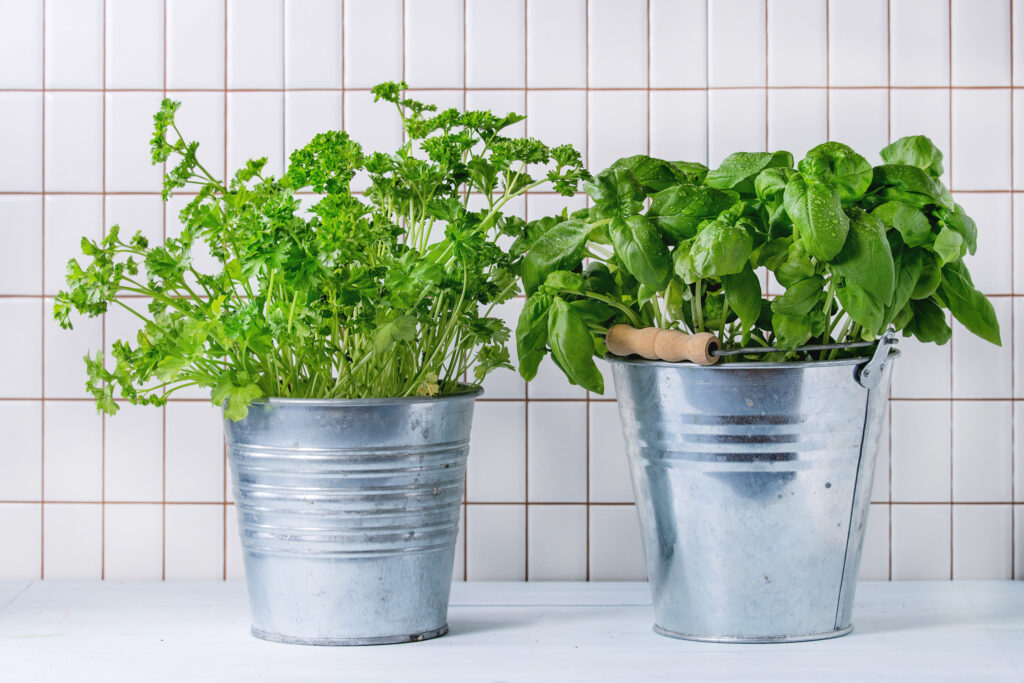
Growing herbs indoors
Many herbs can be grown indoors in a windowsill or under artificial light.
Some herbs can be started in the garden, but others because they have a long growing season and will not flower and produce seeds unless the season is extended by starting indoors. Plants with fine seeds should be started indoors as the seeds can be easily washed away by rain or irrigation outdoors
Herbs best started indoors include cumin, germander, lemon balm, rosemary, savory, sesame, valerian, wormwood, and yarrow. give these herbs a head start indoors for their long growing season.
Herbs that can be grown outdoors all summer in pots and then brought indoors in winter include basil chives, scented geraniums, lemon verbena, marjoram, parsley, thyme, summer savory, and rosemary.
Herbs that should not be started indoors include borage, caraway, and horehound. They do not transplant well.
Light
Herbs grown indoors need a full 6 hours of sun each day. Grow herbs indoors in a sunny windowsill, solarium, greenhouse window, or greenhouse. Herbs growing under fluorescent lights indoors need 14 to 16 hours of light each day.
Rotate plants so that they receive light from all sides. Rotate plants growing on a windowsill regularly.
Two fluorescent tubes in standard housing with a reflector canopy will provide sufficient light for growing herbs. Use fluorescent tubes that simulate sunlight or one that emits cool white light and one that emits warm white light. Replace fluorescent bulbs when they reach about 70 percent of their normal life span.
Place plants growing under fluorescent lights 6 to 12 inches below the lights.
Temperature and humidity
Herbs growing indoors will grow best at about 70°F during the day and about 60°F at night.
A humidity range between 30 and 50 percent is optimal for herbs.
To enhance humidity during the winter when the air is dry, set pots on a bed of gravel in a saucer and keep the gravel bed wet. Evaporating water will raise the humidity around the plants.
Basic care
Water and feed herbs indoors as you would herbs growing in containers (see above).
Combat common indoor pests such as aphids and spider mites with a solution of insecticidal soap; rinse away the soap after several hours.
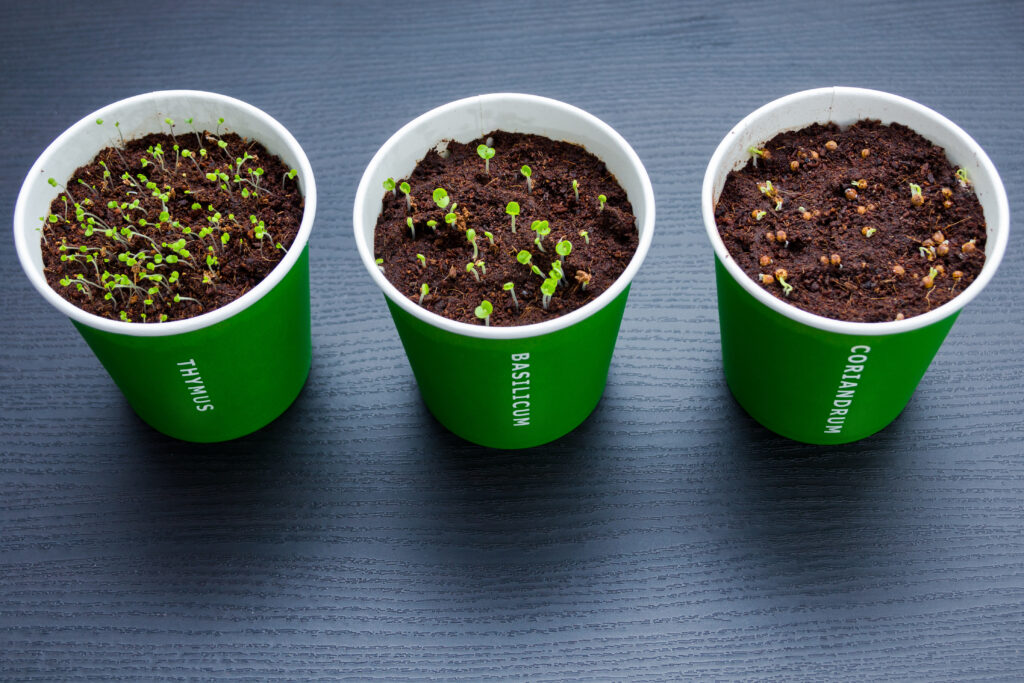
Herb propagation
Herbs can be grown from seeds, cuttings, divisions, and layering.
Seeding
Many herbs can be started indoors in spring for later transplanting into the garden. Some herbs are best sown directly in the garden where they are to grow.
Start seeds in flats, pots, cell packs, or individual peat pots and pressed peat cubes. Fill the container to nearly the rim with light potting soil, apply water to firm the soil, and then scatter the seed over the surface. Cover the seed with a thin layer of potting soil and gently water. Keep the soil moist until the seeds germinate.
When seedlings have a second or third set of true leaves, they can be transplanted to small individual pots to gain size before going into the garden.
Herbs can be sown directly in the garden. Prepare the soil before planting. Cover the seeds lightly with soil and water.
After seedlings germinate, thin out excess plants so that plants can grow to maturity without overlapping the neighbor plant.
Cuttings
Perennial herbs such as rosemary, sage, lavender, scented geraniums, and lemon balm can be propagated by cuttings. In the spring or early summer take 4- to 6-inch cuttings from the ends of stems of healthy, established plants; cut just beneath a pair of leaves, remove the lowest leaves, ad dip the cut end in rooting hormone. Inset the cutting a third of its length into a pot of light potting mix and then water. Keep the soil just moist. Cover the cutting with a plastic bag and put it under strong natural light or fluorescent lights. The cuttings will develop roots in two to four weeks; then remove the plant from the plastic bag.
Transplant rooted cuttings into small individual pots of the same potting mix; set transplants in the garden when roots fill the pot.
Division
Perennial clump-forming herbs such as mint, chives, and French tarragon form clumps of bulbs or rhizomes that can be dug up and separated to create new plants. Dig up the clump, gently remove the soil to reveal the roots, and break the mass into smaller, well-rooted units that can be replanted. Each unit should have roots and stems. Herbs that are propagated by division benefit from being dug and divided every few years.
Layering
Layering is accomplished by choosing a branch close to the ground (such as rosemary, sage, winter savory, and thyme); flexing the stem to the ground, digging a shallow trench, and burying the stem. Remove the leaves that will be covered by soil. Hold the stem in place with a wire loop. Firm the soil around the bent branch. After roots have formed on the buried portion of the stem, sever the exposed stem from the parent plant and move the newly rooted plant to its desired location.
Layering can be done in spring or summer.
Annual, biennial, and perennial herbs
There are annual, biennial, and perennial herbs. An annual herb flowers, sets seeds, and dies all in one year. A biennial herb flowers, sets seeds, and dies over two years. A perennial herb lives from year to year, usually flowering and setting seed in spring and summer, dying to the ground in winter, and regrowing the following spring.
Common annual and biennial herbs
Annual and biennial herbs include angelica, anise, basil, borage, calendula, caraway, German chamomile, chervil, clary, cilantro/coriander, cumin, dill, fennel, garlic, lemon grass, lemon verbena, marjoram, oregano, parsley, American pennyroyal, perilla, rosemary, saffflower, scented geraniums, sesame, summer savory, and watercress.
Biennial herbs such as angelica, caraway, clay, parsley, and watercress can be grown as annuals when they are grown for their leaves which can be harvested at any time.
Common perennial herbs
Common perennial herbs include anise hyssop, artemisia, bee balm, burnet, catnip, Roman chamomile, chives, comfrey, costmary, fennel, germander, ginseng, horehound, horseradish, hyssop, lavender, lavender cotton, lemon balm, lemongrass, lovage, marjoram, mints, oregano, English pennyroyal, rosemary, rue, saffron, sage, scented geraniums, sweet cicely, sweet flag, sweet woodruff, tansy, tarragon, thyme, valerian, winter savory, and yarrow.
Some perennial herbs such as rosemary and thyme are not winter hardy. In cold winter regions, they are often grown as annuals.
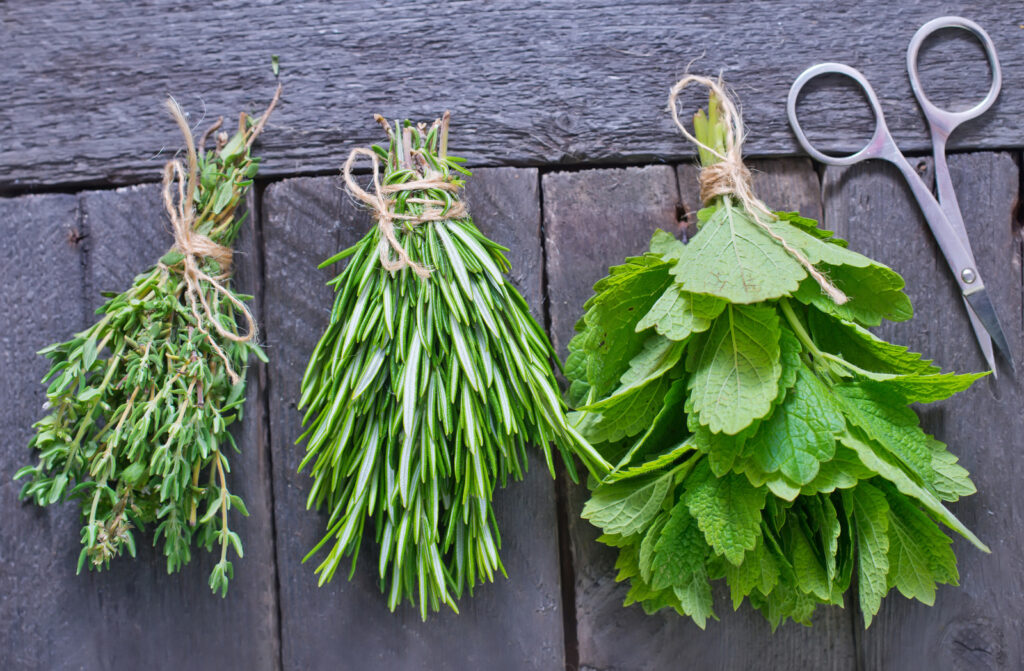
How to grow culinary kitchen herbs
Learn how to plant, grow, and harvest your favorite kitchen herbs. Click below for all you need to know about culinary herbs.
- Anise
- Anise Hyssop
- Arugula
- Basil
- Bay
- Bee Balm
- Borage
- Calendula
- Caraway
- Catnip
- Chamomile
- Chervil
- Chives
- Cilantro-Coriander
- Clary
- Costmary
- Cress
- Dill
- Fennel, Sweet
- Horseradish
- Hyssop
- Lavender
- Lemon Balm
- Lemon Verbena
- Lovage
- Marjoram
- Mint
- Nasturtium
- Oregano
- Parsley
- Perilla
- Rosemary
- Sage
- Salad Burnet
- Savory
- Scented Geranium
- Shiso
- Sorrel
- Stevia
- Sweet Cicely
- Tarragon
- Thyme
Articles of interest:
Best Herbs for Container Growing
Garden Planning Books at Amazon:
- Vegetable Garden Almanac & Planner
- Kitchen Garden Grower’s Guide Vegetable Encyclopedia
- Vegetable Garden Grower’s Guide
- Tomato Grower’s Answer Book


